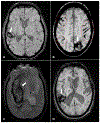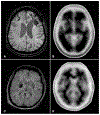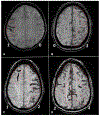The role of biomarkers and neuroimaging in ischemic/hemorrhagic risk assessment for cardiovascular/cerebrovascular disease prevention
- PMID: 33632452
- PMCID: PMC9044196
- DOI: 10.1016/B978-0-12-819814-8.00021-4
The role of biomarkers and neuroimaging in ischemic/hemorrhagic risk assessment for cardiovascular/cerebrovascular disease prevention
Abstract
Stroke prevention in patients with atrial fibrillation is arguably one of the fastest developing areas in preventive medicine. The increasing use of direct oral anticoagulants and nonpharmacologic methods such as left atrial appendage closure for stroke prevention in these patients has increased clinicians' options for optimal care. Platelet antiaggregants are also commonly used in other ischemic cardiovascular and or cerebrovascular conditions. Long term use of oral anticoagulants for atrial fibrillation is associated with elevated risks of major bleeds including especially brain hemorrhages, which are known to have extremely poor outcomes. Neuroimaging and other biomarkers have been validated to stratify brain hemorrhage risk among older adults. A thorough understanding of these biomarkers is essential for selection of appropriate anticoagulant or left atrial appendage closure for stroke prevention in patients with atrial fibrillation. This article will address advances in the stratification of ischemic and hemorrhagic stroke risk among patients with atrial fibrillation and other conditions.
Keywords: Anticoagulation; Antithrombotic; Cerebral amyloid angiopathy; Hypertensive cerebral hemorrhage; Intracerebral hemorrhage; Platelet antiaggregants; Risk scores; Stroke prevention.
Copyright © 2021 Elsevier B.V. All rights reserved.
Figures




Similar articles
-
Percutaneous left atrial appendage occlusion for stroke prevention in patients with atrial fibrillation and contraindication for anticoagulation.Rev Neurol (Paris). 2015 May;171(5):426-32. doi: 10.1016/j.neurol.2014.11.009. Epub 2015 Apr 23. Rev Neurol (Paris). 2015. PMID: 25912470 Review.
-
Left Atrial Appendage Closure for Patients with Cerebral Amyloid Angiopathy and Atrial Fibrillation: the LAA-CAA Cohort.Transl Stroke Res. 2021 Apr;12(2):259-265. doi: 10.1007/s12975-020-00838-5. Epub 2020 Aug 7. Transl Stroke Res. 2021. PMID: 32770310 Free PMC article.
-
Propensity-Matched Comparison of Oral Anticoagulation Versus Antiplatelet Therapy After Left Atrial Appendage Closure With WATCHMAN.JACC Cardiovasc Interv. 2019 Jun 10;12(11):1055-1063. doi: 10.1016/j.jcin.2019.04.004. JACC Cardiovasc Interv. 2019. PMID: 31171282
-
Are Ischemic Strokes the Same? The Special Case Argument of Atrial Fibrillation.Card Electrophysiol Clin. 2023 Jun;15(2):111-117. doi: 10.1016/j.ccep.2023.01.003. Card Electrophysiol Clin. 2023. PMID: 37076223 Review.
-
Are Ischemic Strokes the Same? The Special Case Argument of Atrial Fibrillation.Interv Cardiol Clin. 2022 Apr;11(2):113-119. doi: 10.1016/j.iccl.2021.12.001. Epub 2022 Mar 10. Interv Cardiol Clin. 2022. PMID: 35361456 Review.
Cited by
-
Neuroimaging biomarkers for predicting stroke outcomes: A systematic review.Health Sci Rep. 2024 Jul 1;7(7):e2221. doi: 10.1002/hsr2.2221. eCollection 2024 Jul. Health Sci Rep. 2024. PMID: 38957864 Free PMC article. Review.
-
Left atrial appendage closure for patients with atrial fibrillation at high intracranial haemorrhagic risk.Stroke Vasc Neurol. 2025 Feb 25;10(1):86-94. doi: 10.1136/svn-2024-003142. Stroke Vasc Neurol. 2025. PMID: 38821554 Free PMC article.
-
Stroke Prevention in Atrial Fibrillation: Our Current Failures and Required Research.Stroke. 2024 Jan;55(1):214-225. doi: 10.1161/STROKEAHA.123.040447. Epub 2023 Dec 22. Stroke. 2024. PMID: 38134262 Free PMC article. Review.
References
-
- Bekwelem W, Connolly SJ, Halperin JL et al. (2015). Extracranial systemic embolic events in patients with nonvalvular atrial fibrillation: incidence, risk factors, and outcomes. Circulation 132: 796–803. - PubMed
-
- Blackshear JL, Odell JA (1996). Appendage obliteration to reduce stroke in cardiac surgical patients with atrial fibrillation. Ann Thorac Surg 61: 755–759. - PubMed
MeSH terms
Substances
Grants and funding
LinkOut - more resources
Full Text Sources
Other Literature Sources

